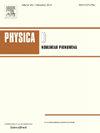推广可压缩两两相互作用扩展点粒子模型
IF 2.9
3区 数学
Q1 MATHEMATICS, APPLIED
引用次数: 0
摘要
弹射物理在强激波作用下的材料界面中起着重要的作用。当冲击冲击固体材料的粗糙表面并使其熔化时,richhtmyer - meshkov不稳定性会在表面产生扰动,从而喷射出粒子。释放后,喷出物穿过激波后的可压缩流。为了准确地模拟大量的喷射粒子,最好采用欧拉-拉格朗日方法,这需要对涉及流体-粒子相互作用的亚网格尺度物理进行建模。我们推广了Hsiao等人(2023)之前的工作,以考虑受任何负载冲击影响的运动粒子系统。进行了以下改进:(1)允许粒子相互相对移动(2)考虑了非平面冲击并允许可变冲击速度。对该算法进行了典型测试用例的粒子分解模拟测试。对这些试验结果进行了讨论和分析。本文章由计算机程序翻译,如有差异,请以英文原文为准。
Generalizing the compressible pairwise interaction extended point-particle model
Ejecta physics plays an important role in material interfaces that are impacted by a strong shock wave. When a shock impacts a rough surface of solid material and melts it, the Richtmyer–Meshkov instability grows perturbations on the surface, which can eject particles. After release, the ejecta travel through the post-shock compressible flow. To accurately simulate a large number of ejecta particles, an Euler–Lagrange approach is preferred, which requires modeling the subgrid-scale physics involved with fluid–particle interactions. We generalize the previous work from Hsiao et al. (2023) to consider systems of moving particles subject to any loading shock. The following improvements were made: (1) Particles are allowed to move relative to each other (2) Non-planar shocks are accounted for along with allowing for variable shock speeds. The generalized algorithm was tested with particle-resolved simulations for canonical test cases. The results of these tests are discussed and analyzed.
求助全文
通过发布文献求助,成功后即可免费获取论文全文。
去求助
来源期刊

Physica D: Nonlinear Phenomena
物理-物理:数学物理
CiteScore
7.30
自引率
7.50%
发文量
213
审稿时长
65 days
期刊介绍:
Physica D (Nonlinear Phenomena) publishes research and review articles reporting on experimental and theoretical works, techniques and ideas that advance the understanding of nonlinear phenomena. Topics encompass wave motion in physical, chemical and biological systems; physical or biological phenomena governed by nonlinear field equations, including hydrodynamics and turbulence; pattern formation and cooperative phenomena; instability, bifurcations, chaos, and space-time disorder; integrable/Hamiltonian systems; asymptotic analysis and, more generally, mathematical methods for nonlinear systems.
 求助内容:
求助内容: 应助结果提醒方式:
应助结果提醒方式:


